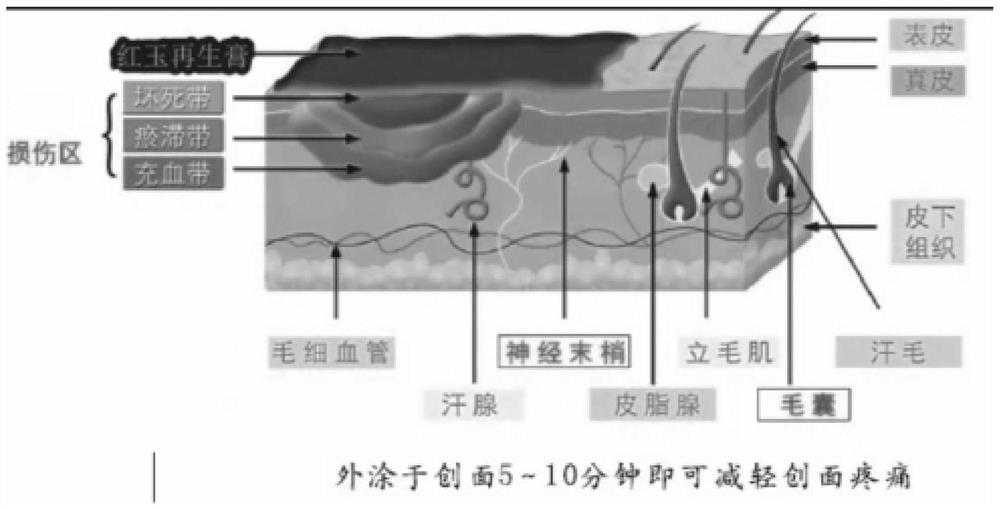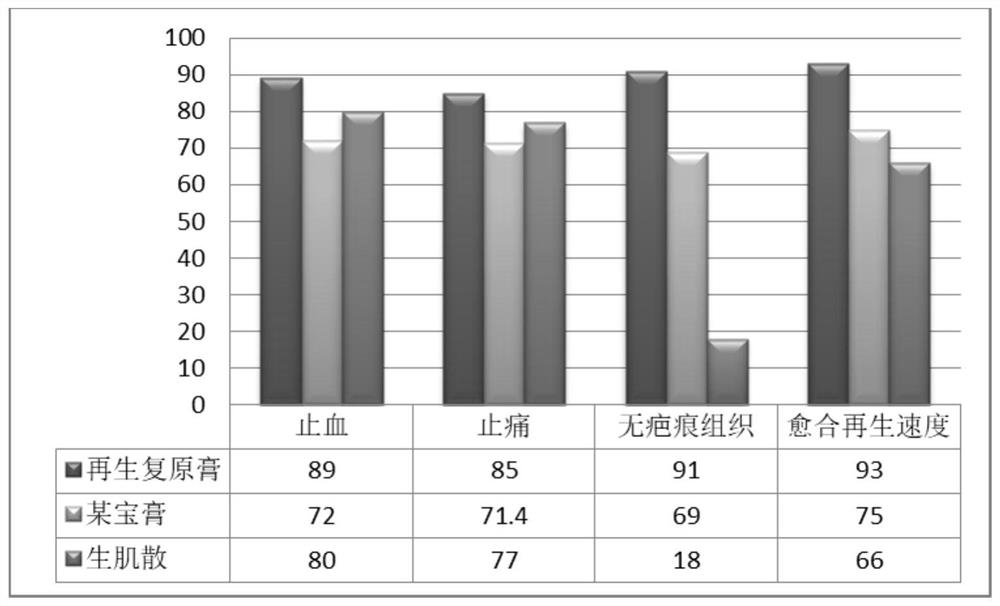Ruby regeneration ointment and preparation process thereof
A preparation process, the technology of ruby, which is applied in the field of medicine, can solve the problems of slowing down the speed of cell division and proliferation, forming scabs, increasing the workload of nursing, etc.
- Summary
- Abstract
- Description
- Claims
- Application Information
AI Technical Summary
Problems solved by technology
Method used
Image
Examples
Embodiment 1
[0038] In the embodiment of the present invention, a kind of red jade regeneration paste includes the following raw materials according to the weight in grams: 30g of calamine, 30g of amber, 30g of rhubarb, 10g of dragon's blood, 10g of octopus, 30g of gardenia, 30g of angelica, calcined gypsum 100g, natural borneol 30g, vaseline 1900g, camellia oil 25g, lanolin 100 parts.
[0039] A preparation process of red jade regeneration paste, comprising the following steps:
[0040] 1) Crush calamine, amber, rhubarb, dragon's blood, sea octopus, gardenia, angelica, calcined gypsum, natural borneol, respectively, pass through a 200-mesh sieve, and set aside;
[0041] 2) Weigh Vaseline, tea oil, and lanolin, mix them, heat to 75°C, then cool to 60°C, add rhubarb, angelica, calamine, amber, gardenia, calcined gypsum, and natural borneol. After stirring for 10 minutes, add dragon's blood, sea octopus, and natural borneol, and stir while adding until it drops to room temperature.
Embodiment 2
[0043] In the embodiment of the present invention, a ruby regeneration paste comprises the following raw materials according to the weight in grams: 120g of calamine, 120g of amber, 120g of rhubarb, 50g of dragon's blood, 50g of octopus, 120g of gardenia, 120g of Angelica dahurica, calcined gypsum 300g, natural borneol 90g, vaseline 2100g, camellia oil 35g, lanolin 110 parts.
[0044] A preparation process of red jade regeneration paste, comprising the following steps:
[0045] 1) Crush calamine, amber, rhubarb, dragon's blood, sea octopus, gardenia, angelica, calcined gypsum, natural borneol, respectively, pass through a 200-mesh sieve, and set aside;
[0046] 2) Weigh Vaseline, tea oil, and lanolin, mix them, heat to 85°C, then cool to 70°C, add rhubarb, angelica, calamine, amber, gardenia, calcined gypsum, and natural borneol. After stirring for 40 minutes, add dragon's blood, sea octopus, and natural borneol, and stir while adding until it drops to room temperature.
Embodiment 3
[0048] In the embodiment of the present invention, a kind of red jade regeneration paste comprises the following raw materials according to the weight in grams: 40g of calamine, 40g of amber, 40g of rhubarb, 20g of dragon's blood, 20g of octopus, 40g of gardenia, 40g of flavescens, and Angelica dahurica 40g, pearl 20g, calcined gypsum 120g, natural borneol 40g, vaseline 1950g, camellia oil 25g, lanolin 105 parts.
[0049]A preparation process of red jade regeneration paste, comprising the following steps:
[0050] 1) Crush calamine, amber, rhubarb, dragon's blood, sea octopus, gardenia, flavescens, angelica dahurica, pearl, calcined gypsum, natural borneol, mint, pass through a 200-mesh sieve, and set aside;
[0051] 2) Weigh Vaseline, tea oil, and lanolin, mix them, heat to 78°C, and then cool to 62°C, add rhubarb, angelica, calamine, amber, gardenia, calcined gypsum, and natural borneol. After stirring for 15 minutes, add dragon's blood, sea octopus, and natural borneol, an...
PUM
 Login to View More
Login to View More Abstract
Description
Claims
Application Information
 Login to View More
Login to View More - R&D
- Intellectual Property
- Life Sciences
- Materials
- Tech Scout
- Unparalleled Data Quality
- Higher Quality Content
- 60% Fewer Hallucinations
Browse by: Latest US Patents, China's latest patents, Technical Efficacy Thesaurus, Application Domain, Technology Topic, Popular Technical Reports.
© 2025 PatSnap. All rights reserved.Legal|Privacy policy|Modern Slavery Act Transparency Statement|Sitemap|About US| Contact US: help@patsnap.com



